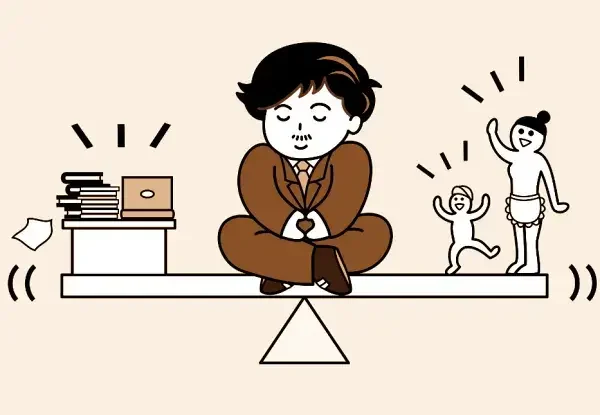Balance isn’t just critical for massive ocean liners it has become a key condition for well-being in modern life, especially in the delicate dance between our professional and personal spheres.
This secure and steady state refers to the coordination of both domains to achieve harmony and a sense of fulfillment.
Such balance is essential, as it directly influences our quality of life, productivity, and overall satisfaction. Numerous factors can determine how easily or how challengingly this balance is maintained.
Balance and life.
One major factor is workload. Excessive demands can lead to stress and disrupt the sense of stability in our already hectic lives.
When work begins to consume more time than we can reasonably give, it often comes at the expense of personal life. This imbalance may lead to burnout, reducing not only productivity but also our general zest for life.
On the other hand, manageable workloads and effective time management can improve well-being significantly. Perhaps this isn’t new information, but it certainly reflects the reality of modern life.
The Environment and the Individual.
Our work environment plays a significant role in shaping our well-being. A supportive and understanding atmosphere promotes a sense of stability. In contrast, conflicting relationships or lack of peer support can make it difficult to maintain a healthy balance.
Friendly relations with colleagues and managers can foster effective collaboration, while strained relationships often increase stress.
Outside of work, meaningful connections with family and friends are essential for emotional stability. However, when work consistently overshadows personal life, relationships can suffer, further destabilizing that delicate balance.
The Risks and Consequences of Burnout.
Burnout is a serious issue that affects both professional performance and personal life. It’s marked by emotional, mental, and physical exhaustion resulting from prolonged stress.
Even the most driven professionals can fall victim to burnout if warning signs are ignored and boundaries between work and rest go unmaintained.
Studies show that around 25% of people regularly experience burnout symptoms, underscoring how widespread and impactful this issue is.
Burnout can reduce productivity and cause emotional strain in personal relationships.
A burned-out individual often feels isolated, anxious, or depressed—feelings that may only deepen their emotional distress. Physical symptoms can include headaches, sleep disorders, and chronic pain—just a few of the consequences of unhealthy work dynamics.
Research further indicates that prolonged burnout increases risks for severe health problems like heart disease and immune system dysfunction.
That’s why it’s vital to take proactive steps to safeguard both mental and physical health—both our own and that of our coworkers.
Regular breaks, balanced work-life activities, and a healthy routine can help prevent this instability. It’s a simple truth: supporting a positive work environment benefits everyone.
Practical Tips for Achieving Balance.
To truly master the balance between work and personal life, it’s important to apply strategies that reduce stress and encourage positivity. Effective time management is essential. Use calendars and planners to schedule important tasks and include designated breaks.
Consider techniques like the Pomodoro Method, 25-minute focused work sessions followed by short breaks. Add a lighthearted joke or an uplifting message from a manager, and suddenly productivity feels more sustainable.
Prioritization is key.
Evaluate your daily tasks and identify the most important ones. This helps focus energy on what matters and reduces time wasted on minor duties.
When possible, delegate tasks. Look to your team for support and distribute responsibilities to improve collaboration and reduce pressure.
Emotional support is another crucial piece of the puzzle. Take time to connect with colleagues who can offer advice or motivation. Consider joining support groups, interest-based activities, or seeking guidance from a professional counselor if needed.
Meditation apps, stress management courses, and mentorship opportunities can further boost your emotional well-being and help maintain balance. These tools make it easier to align your personal and professional lives with greater harmony.
The Role of Support and Relationships.
Achieving work-life balance depends heavily on our social interactions. The support of coworkers, friends, and family plays a vital role in helping us manage these two major areas of life.
Relationships both at work and home are often central to emotional support and healthy communication. A positive work environment and strong peer connections can provide clarity, reduce stress, and promote understanding.
Conversely, negative dynamics can make balance much harder to achieve.
Open, constructive dialogue with colleagues is crucial to fostering a healthier workplace climate. At home, emotionally nurturing relationships with family members lay the foundation for personal well-being.
Tension in family life can negatively impact our professional and emotional health. That’s why it’s important to invest time in family activities that foster closeness and understanding. Friends, too, are invaluable they offer a space to relax and share personal thoughts and feelings.
Nurturing these social ties improves overall life satisfaction and supports a balanced lifestyle.
The quality of your relationships and the emotional support they provide is key to sustaining a healthy balance between work and life.
Creative Thinking and Mental Balance.
Interestingly, this kind of mindset often leads to innovative thinking, allowing us to solve workplace challenges and bring fresh ideas to life.
Creative thinking itself benefits from structure you can design your own system or algorithm for approaching different types of problems creatively.
This article also highlights the psychological benefit of creative thinking: it can break mental blocks and offer new perspectives.
Creativity isn’t a luxury it’s a necessity for innovation, resilience, and growth.
Albert Einstein’s Thoughts on Creativity (Still Relevant Today!):
1. A person who never made a mistake never tried anything new.
2. Education is what remains after one has forgotten everything he learned in school.
3. Imagination is more important than knowledge. Knowledge is limited. Imagination encircles the world.
4. The secret to creativity is knowing how to hide your sources.
5. Try not to become a man of success, but rather try to become a man of value.
6. There are two ways to live: you can live as if nothing is a miracle; you can live as if everything is a miracle.
7. To lead a flock of sheep perfectly, one must become a sheep first.
8. You have to learn the rules of the game. And then you have to play better than anyone else.
9. It is important to never stop questioning. Curiosity has its own reason for existing.
10. The more famous I become, the more stupid I get—and that seems to be a general rule of life.
Final Thought.
The key to success lies in innovation innovation born from creativity, and creativity fueled by maintaining balance.
Have a great day!




